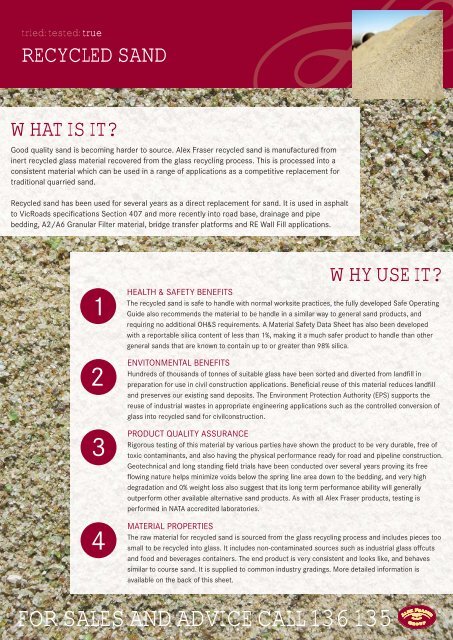TIS recycled sand V4.indd - Alex Fraser Group
TIS recycled sand V4.indd - Alex Fraser Group
TIS recycled sand V4.indd - Alex Fraser Group
You also want an ePaper? Increase the reach of your titles
YUMPU automatically turns print PDFs into web optimized ePapers that Google loves.
tried: tested: true<br />
RECYCLED SAND<br />
WHAT IS IT?<br />
Good quality <strong>sand</strong> is becoming harder to source. <strong>Alex</strong> <strong>Fraser</strong> <strong>recycled</strong> <strong>sand</strong> is manufactured from<br />
inert <strong>recycled</strong> glass material recovered from the glass recycling process. This is processed into a<br />
consistent material which can be used in a range of applications as a competitive replacement for<br />
traditional quarried <strong>sand</strong>.<br />
Recycled <strong>sand</strong> has been used for several years as a direct replacement for <strong>sand</strong>. It is used in asphalt<br />
to VicRoads specifi cations Section 407 and more recently into road base, drainage and pipe<br />
bedding, A2/A6 Granular Filter material, bridge transfer platforms and RE Wall Fill applications.<br />
1<br />
2<br />
3<br />
4<br />
WHY USE IT?<br />
HEALTH & SAFETY BENEFITS<br />
The <strong>recycled</strong> <strong>sand</strong> is safe to handle with normal worksite practices, the fully developed Safe Operating<br />
Guide also recommends the material to be handle in a similar way to general <strong>sand</strong> products, and<br />
requiring no additional OH&S requirements. A Material Safety Data Sheet has also been developed<br />
with a reportable silica content of less than 1%, making it a much safer product to handle than other<br />
general <strong>sand</strong>s that are known to contain up to or greater than 98% silica.<br />
ENVITONMENTAL BENEFITS<br />
Hundreds of thou<strong>sand</strong>s of tonnes of suitable glass have been sorted and diverted from landfi ll in<br />
preparation for use in civil construction applications. Benefi cial reuse of this material reduces landfi ll<br />
and preserves our existing <strong>sand</strong> deposits. The Environment Protection Authority (EPS) supports the<br />
reuse of industrial wastes in appropriate engineering applications such as the controlled conversion of<br />
glass into <strong>recycled</strong> <strong>sand</strong> for civilconstruction.<br />
PRODUCT QUALITY ASSURANCE<br />
Rigorous testing of this material by various parties have shown the product to be very durable, free of<br />
toxic contaminants, and also having the physical performance ready for road and pipeline construction.<br />
Geotechnical and long standing fi eld trials have been conducted over several years proving its free<br />
fl owing nature helps minimize voids below the spring line area down to the bedding, and very high<br />
degradation and 0% weight loss also suggest that its long term performance ability will generally<br />
outperform other available alternative <strong>sand</strong> products. As with all <strong>Alex</strong> <strong>Fraser</strong> products, testing is<br />
performed in NATA accredited laboratories.<br />
MATERIAL PROPERTIES<br />
The raw material for <strong>recycled</strong> <strong>sand</strong> is sourced from the glass recycling process and includes pieces too<br />
small to be <strong>recycled</strong> into glass. It includes non-contaminated sources such as industrial glass off cuts<br />
and food and beverages containers. The end product is very consistent and looks like, and behaves<br />
similar to course <strong>sand</strong>. It is supplied to common industry gradings. More detailed information is<br />
available on the back of this sheet.<br />
FOR SALES AND ADVICE CALL 136 135
tried: tested: true<br />
RECYCLED SAND<br />
MATERIAL PROPERTIES GRADING LIMITS*<br />
Application Bedding & Backfi lling Material<br />
Maximum Dry Density * 1.8 tm3<br />
Optimum Moisture Content % * 9 -11<br />
Colour Brown / Green / Grey<br />
Ph 7.5 - 9<br />
Plasticity Index Non Plastic<br />
Californian Bearing Ratio @ 5mm % * 50 - 75<br />
Swell Nil<br />
Degradation Factor * 94<br />
Sand Equivalent * 75 - 80<br />
Sodium Sulphate Soundness Individual Loss % * 0.1<br />
Shear Box Friction Angle Degree @300mm * 37 - 41<br />
Choride as CI % *


